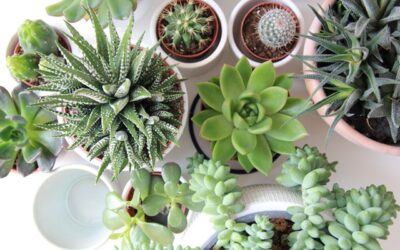Fancy some whale’s tongue? How about pig’s ear? Flapjack? Chocolate soldier for desert?
No, these are not culinary offerings. They’re just a few of the hundreds of evocative names for the plant species known as “succulents”.
The name derives from the Latin word “sucus”, meaning juice. It refers to the plant’s remarkable ability to absorb and store moisture, allowing it to thrive in arid environments.
That trait is the one quality that all succulents share.
But they’re a highly diverse clan, prized by their owners for their individuality. If you’re in the market for one of these quirky plants, your only problem will be choosing from among the thousands of varieties on tap.
All the family

This species is amazingly diverse. It includes close to 60 different succulent families, encompassing about 10,000 varieties.
Succulents are the rebels of the plant world. Unlike most other species, they don’t play it safe with standard-issue green. They’re known to flaunt flamboyant splashes of colour in their leaves or in the flowers which many varieties grow.
Nor do they adhere to a one-size-fits-all rule when it comes to shape and texture. They may be spikey and compact, like many cacti, or they may grow elaborate vines, like the burro’s tail, or they may resemble extraterrestrial life forms, like the twisting trachyandra.

Succulents push beyond the botanical boundaries. Yes, they’re great for adding a pop of colour to a garden or home – but they’re also showing up in everything from wedding parties to wall art to jewellery.
Succulent sleuthing
The thousands of varieties already in existence are being continually crossbred by growers around the world, meaning new hybrids are regularly added to the succulent family.
Correctly identifying a second- or third-generation member can be a real challenge. But if you don’t know what your plant is, you won’t know what sort of care it craves.
Devising the right care regimen for your succulent can mean the difference between raising a happy, healthy plant or causing its untimely demise.
If you have a plant that you can’t identify, have a look at some of the distinguishing features below:
- Leaf: size, shape, thickness, texture
- Colour: of flowers, leaves, stems
- Bumps or marks on leaves
- Flower: colour, shape, number of petals and blooms
- Stem: length, colour, texture, thickness
- Ciliate hairs on leaves
- Epicuticular wax
- Plant texture: smooth or spikey
- Plant shape and size
There are plenty of plant enthusiasts – including bloggers, gardening groups, and nursery owners – who will be more than happy to help you investigate.
Take a well-lit photo of your plant, include a summary of the characteristics listed above, and share it with other curious cultivators. Succulent enthusiasts are everywhere (including online), so chances are good that someone can help put a name to your plant.
Family snapshots
It’s impossible to present the entire family tree, but below are snapshots of some of its branches.
Indoor Succulents

These thrive in dry, room-temperature spaces. They like filtered or direct sunlight.
Echeveria
Available in a rainbow of colours, their rosette-like shape makes them ideal decorative plants. Low maintenance – wide popularity.
Aloe Vera
An attractive and resilient evergreen known as the “wonder plant” for its medicinal benefits. A great natural healer to have on hand for soothing burns and scrapes.
Burro’s Tail (sedum morganianum)
Also known as “donkey’s tail”, named for its ability to grow long, tail-like vines shape up to four inches long.
Jade Plant (crassula ovata)
Features thick, shiny leaves that grow in an oval shape. On maturing, it grows white or pink star-shaped flowers.
Crown of Thorns (euphorbia milii)
Thrives in dry indoor environments and requires little watering. A visual delight with its crown of flowers.

Flaming Katy (kalanchoe blossfeldiana)
Produces brilliant buds and flowers in deep red, gold, and white. Makes an attractive table centrepiece.
Pincushion Cactus (mammillaria crinita)
Looks just as it sounds – a cute little pincushion of a plant under six inches tall. But it’s not all spikes: it also produces brightly coloured blooms.
Snake Plant (sansevieria trifasciata)
One of the easiest varieties to grow because it tolerates neglect – i.e., continues to look fresh even when you “forget” to water it. Research suggests it can improve home air quality by removing toxins.
Outdoor Succulents
These are a great way to add colour and variety to your garden, and can be planted either in the ground or in containers.
Hens-and-Chicks (sempervivum tectorum)
The Latin name means “live forever”, which they do by producing offspring known as “chicks”. This variety includes over 3,000 species, and offers a wide selection of colours.
Whale’s Tongue Agave (agave ovatifolia)
We can’t know for sure what a whale’s tongue looks like – but we do know this variety grows up to five feet tall, and produces flower spikes up to 14 feet in height. Definitely one for the great outdoors.
Ball Cactus (parodia magnifica)

One of the most popular outdoor succulents, particularly with gardeners interested in water conservation. This spikey desert native – surprise! – produces clusters of small yellow flowers.
Pig’s Ear (cotyledon orbiculata)
Yes – with its thick, red-edged oval leaves, it really does resemble its namesake. But it compensates by growing up to four feet high and sprouting pretty red and yellow flowers. (A good silk purse/sow’s ear story.)
Torch Aloe (aloe aborescens)
More flamboyant than its cousin aloe vera, the torch aloe can reach heights of ten feet, and sports bright reddish-orange spikes. An ideal outdoor accent plant.

THINKING OUTSIDE THE (PLANTER) BOX
There’s a reason succulents are so popular. Yes, their maintenance requirements are low, and their lifespans long.
But more importantly, succulents are all about diversity. From minimalist to elaborate, monotoned to multi-coloured, traditional to downright quirky, they dare you to be creative.
Check out some of their profiles online, fire up your imagination, and swipe right for a succulent match that will be a good fit for your garden, your windowsill … or perhaps, even your shoes.


0 Comments